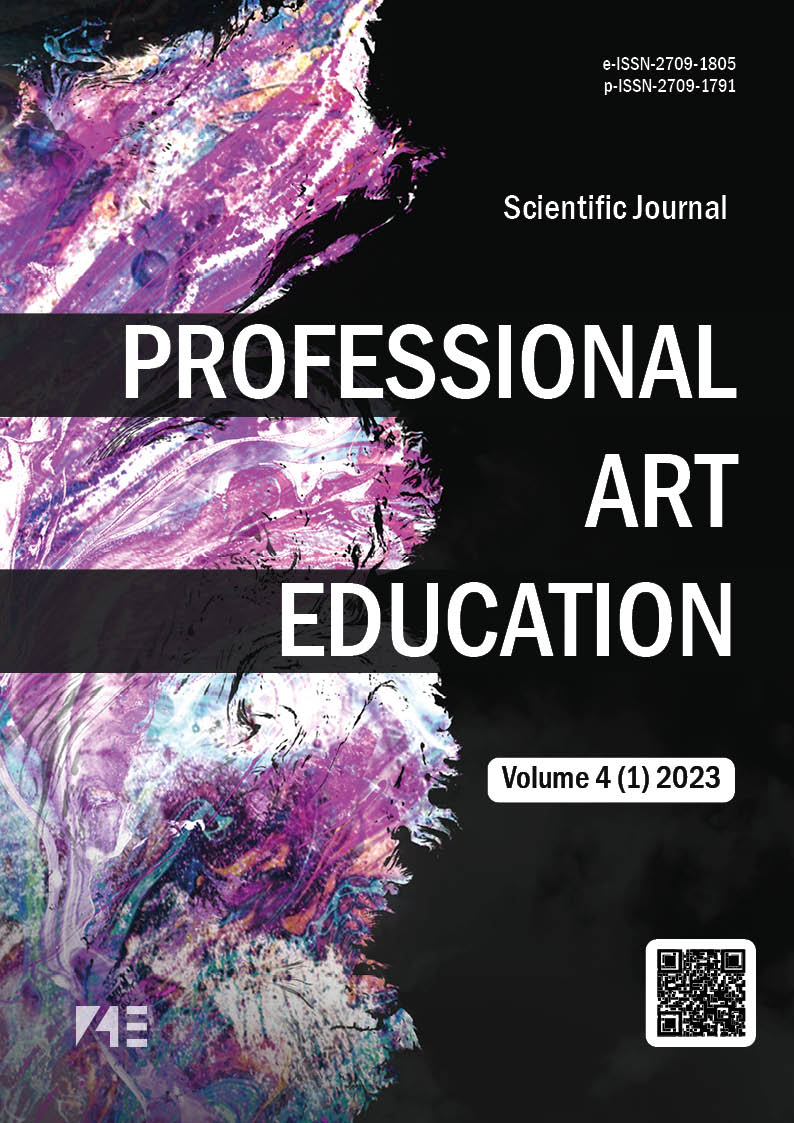Features of aesthetic education of teenagers using fine arts
DOI:
https://doi.org/10.34142/27091805.2023.4.01.01Keywords:
pedagogical conditions, adolescents, aesthetic education, artistic image, fine artsAbstract
The purpose of the article is to determine the features and mechanisms of modernization of pedagogical conditions of aesthetic education of adolescents by means of fine arts, to analyze modern innovative technologies used in this process.
Methods and methodology. The methodological basis and an important principle of aesthetic education at the present stage is the idea of an integrated approach, which in the implementation of the system of aesthetic education has a double meaning: the system of aesthetic education should be built on the basis of artistic images that constantly interact with each other in the process of influencing the adolescent, that is, the need for close interaction of art on the basis of interdisciplinary connections is organized; aesthetic education as education by means of the visual arts and by means of reality should become an organic part of the process of aesthetic education. Theoretical methods are used in the article: comparison, systematization and generalization of scientific sources on the use of fine arts as a means of aesthetic education of adolescents.
The scientific novelty of the article is to clarify the content of the concept of "aesthetic education", to propose organizational and pedagogical conditions that ensure the effectiveness of aesthetic education of adolescents in the process of teaching fine arts.
Results. The positive role of subjective perception and experience of works of art, which allow to realize their objective aesthetic meaning, is recognized. The significance of thinking activity, the ability of adolescents to "co-action" and "empathy" through figurative and conceptual generalization is revealed. The relationship between the individual (specific sensory form, figurative generalization) and the general (sensory perception of the multifaceted essence of the depicted phenomenon) is analyzed. The content of the reproductive (fragmentary and plot sublevels); emotional-artistic; intuitive-artistic; and conscious-artistic levels of perception of works of fine art is substantiated. The results of the study can be used in the pedagogical practice of primary schools, as well as for the development of teaching aids, didactic materials for pedagogical institutions of secondary and special education, higher education institutions.
Downloads
References
Дем’янчук, О.Н., Чихурський, А.С., Берлач, О.П. (2017). Естетизація навчально-виховного процесу загальноосвітньої школи-інтернату: монографія. 219 с. https://evnuir.vnu.edu.ua/bitstream/123456789/13077/1/estetyzaciia_monograf.pdf
Джола, Д.М. (1998). Теорія і методика естетичного виховання школярів / Д.М. Джола, А.Б. Щербо: навч.-метод. посібник. 78 с.
Дроздова, М.А. (2006). Психологія мистецтва: навч.посібник для студентів. 104 с. https://epub.chnpu.edu.ua/jspui/bitstream/123456789/524/1/Психологія%20мистецтва.pdf
Естетичне виховання дітей та молоді: теорія, практика, перспективи розвитку: збірник наук. пр. / за ред. О. А. Дубасенюк, Н. Г. Сидорчук. 2012. 560 с. http://eprints.zu.edu.ua/13575/1/ЗБИРНИК%20праць%20Естетичне%20виховання_А.pdf
Кучер, С.Л. (2000). Формування цілісного світосприйняття підлітків засобами народного образотворчого мистецтва. Педагогіка і психологія формування творчої особистості: проблеми і пошуки: Вип. 19. 73-78 https://scholar.google.com.ua/citations?hl=uk&user=6VnKLewAAAAJ&view_op=list_works&sortby=title
Мартинюк, І. (2005). Естетичне виховання: теорія і методологія. 158 с. https://uhsp.edu.ua/personnel/martynyuk-anatolij-kyrylovych/
Професійна підготовка майбутнього вчителя образотворчого мистецтва : теоретичний аспект : колективна монографія / [М.О. Пічкур, Г.І. Сотська, О.В. Семенова та ін.]. 2017. 390 с. https://dspace.udpu.edu.ua/bitstream/6789/8391/1/MONOGRAFIJA%20OM.pdf
Ревенко, І.В. (2010). Художньо-естетичне виховання підлітків як психолого-педагогічна проблема. Педагогіка формування творчої особистості у вищій та загальноосвітній школах №13. 181-186 http://pedagogy-journal.kpu.zp.ua/archive/2010/13/33.pdf 2010,
Роменець, В. А. (2001). Психологія творчості : навч. посіб. [2-ге вид., доп.]. 288 с. https://chtyvo.org.ua/authors/Romenets_Volodymyr/Psykholohiia_tvorchosti/
Рудницька, О.П. (2005). Педагогіка: загальна та мистецька : навч. посібник. Тернопіль: Навчальна книга. Богдан. 153 с. https://bohdan-books.com/upload/iblock/560/560fc615be7f2c4f530c49a60f4b5fc4.pdf
Самойленко, О.І. (2020). Психологія мистецтва: сучасні музикознавчі проекції : монографія 236 с. https://musicologicalschool.com/wpcontent/uploads/2023/03/СамойленкоПСИХОЛОГІЯМИСТЕЦТВА-preview-2-1.pdf
Стасюк, Н.А. (2009). Естетичне виховання молодших школярів засобами образотворчого мистецтва. Педагогічні науки. № 5. 23 – 31. :http://lib.chdu.edu.ua/pdf/naukpraci/pedagogika/2006/46-33-11.pdf.
Фомін, В. В. (2007). Індивідуальний підхід в естетичному вихованні учнівської молоді у навчальних закладах України другої половини XIX–початку ХХ століття (Doctoral dissertation, автореф. дис. на здобуття наукового ступеня канд. пед. наук: спец. 13.00. 01 «Загальна педагогіка та історія педагогіки, 20 с.
Чихурський, А.С. (2012). Педагогічні умови естетичного виховання підлітків засобами образотворчого мистецтва (історичний та естетико-педагогічний аспект, огляд джерел). Гуманізація навчально-виховного процесу Спецвипуск 8. Ч. ІІ, С.263-269 https://evnuir.vnu.edu.ua/bitstream/123456789/13525/3/chyhur.pdf
Чихурський, А.С. (2016). Естетизація навчально-виховного процесу загальноосвітньої школи-інтернату (кінець ХХ – початок ХХІ століття) : [Дис.…канд. пед. наук: 13.00.01, Східноєвропейський національний університет імені Лесі Українки]. 265 с. http://eprints.zu.edu.ua/20304/1/dys_Chuhurskij.pdf
Downloads
Published
License
Copyright (c) 2023 Дем’янчук Олександр Никанорович (Автор)

This work is licensed under a Creative Commons Attribution-NonCommercial 4.0 International License.














